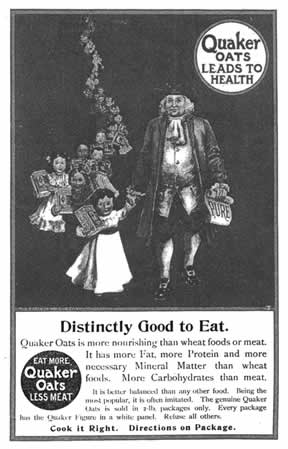

Selling the Goods
|
 |
Review previous lesson QUIZ
Introduction- The Consumer Economy
New Role of Advertising
 |
Quaker Oats was marketing's first brand named packaged goods success
|
Building the "Brand"
A New Culture of Consumption
Selling- Hard versus Soft Sell/ Honesty in Advertising:
John Powers Copywriter -Wanamaker Department Store
|
 |
Slogans and Jingles
He wrote -
He rose, she took the seat and said,
"I thank you," and the man fell dead. But, ere he turned a lifeless lump,
He murmured, "Do you see that HUMP?"It made no sense, but perhaps that piqued curiosity.
 |
 |
With his invention of the flexible film in 1884, and the Kodak camera in 1888, George Eastman made photography possible for almost everyone. His product became associated with beautiful Kodak Girls Hear three Kodak tunes on this PBS site- http://www.pbs.org/wgbh/amex/eastman/sfeature/music.html read about Kodak history at http://www.kodak.com/US/en/corp/kodakHistory/index.shtml Read more about Kodak in The Triumph of Kodakery:The Camera Maker May Die, But the Culture it Created Survives by Alexis Madrigal (Jan 6, 2012) |
The Visual Image

see more Remington http://xroads.virginia.edu/~HYPER/ |
see more Jesse Wilcox Smith http://giam.typepad.com/100_years_of_ |
 |
Stereotypes in Ads
 |
 |
 |
National Advertising
 |
Marketing Technology
 |
In 1888 George Eastman, a high school drop out, introduced his Kodak (an invented name) small black camera box for $25. After use, customers shipped the entire box back to develop the film and to reload it; his "you press the button, we do the rest" quickly became part of everyday language; he advertised in magazines that catered to those able to afford the $25 |
|
see the Bicycle Museum of America see some vintage ads |
 |
Rise of Advertising Agencies
Cyrus H.K. Curtis expanded advertising in magazines- began as a weekly 4 page and turned it into Ladies Home Journal (1883)
|
 |
New Design
William Morris style above Arts & Crafts style to right |
 |
|
Sources:
Johnston, Russell. Selling Themselves: The Emergence of Canadian Advertising,Toronto: University of Toronto Press, 2001.
Silvulka, Juliann. Soap, Sex & Cigarettes. Belmont, CA:Wadsworth Publishing, 1998.
Reichert, Tom. The Erotic History of Advertising, New York: Prometheus Books , 2003.
Madrigal, Alexis, The Triumph of Kodakery:The Camera Maker May Die, But the Culture it Created Survives The Atlantic Jan 6, 2012
Jim Crow Museum of Racist Memorabilia at Ferris State University http://www.ferris.edu/news/jimcrow/
John Wanamaker http://www.wanamakerorgan.com/johnw.html
John Powershttp://en.wikipedia.org/wiki/John_Emory_Powers
William Morris and Arts and Crafts Movement Arts and Crafts Movement
and those noted in body of notes